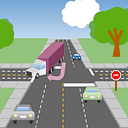Common Sense
Why A.I. seems to lack it
Imagine you asked an A.I. to cook you some food. You might think that’s a straightforward request. When you compare it to more creative tasks like painting, following a cooking recipe is routine.
And yet something crucial is missing. Even though you could train it to follow a recipe to its minutest detail, the A.I. is doomed to fail. Why? Because it doesn’t know what food is. It doesn’t know what food means. Here’s why.
How To Be Flexible
There are an infinite number of things that could go wrong while cooking. The temperature of the oven could vary by manufacturer, or the ingredients used may have gone bad. There may be an unexpected typo in the recipe.
One of the greatest hurdles with current A.I. is that it tends to break down if it has to step outside the narrow limits of what it’s prepared to do.
Granted, the same could be said of us humans, but the errors with A.I. are often unnerving. A child may occasionally confuse a dog with a cat. An A.I. will sometimes confuse a dog with a nuclear power plant. Observing such errors, you might feel the A.I. is missing something. You could call it “common sense”.
Try to define common sense. It’s tricky isn’t it? The most common definition I’ve heard is that humans have a knack for finding patterns, and applying what they’ve found to novel situations. That way every new experience has a bank of others to draw on.
That’s a good start. That introduces a new problem, however. What does it mean to “find patterns” in your experiences?
Put a pin in that thought. Let’s get back to cooking.
Say there were a typo in the recipe, and the word “egg” were replaced with “peg”. Unless the A.I. somehow knew better, it may end up putting clothes-pegs in the mixing bowl. What’s worse, it would not realize it had done anything wrong.
But surely it’s “common sense” to not put clothes-pegs in a cake? Yes it is. Indeed, if instead of eggs the A.I. had put eggnog in the bowl, you might be more forgiving of the error, since that sounds like an honest mistake. But stirring in Tonka Trucks makes you doubt the reliability and safety of the A.I.
So how do you give an A.I. “common sense”?
What’s the Goal?
When you told the A.I. you’d like some food, you had an ulterior motive. What you really meant was “I’m hungry, and I’d like something delicious to eat”. Your goal, that is, the meaning behind your words, would be clear to any of your friends. If a friend were cooking for you, she would know that the word “pegs” was likely a typo, because she herself would never want to eat clothes-pegs if she were hungry.
Your human friend has an advantage over the A.I. She knows what hunger is, and what she’d like to eat. This is where her common sense comes to the foreground. This is also why you’d be more forgiving if she added eggnog instead of eggs, since that is something you might eat.
Your friend’s advantage is that she shares your goals, namely hunger and taste. “Common sense” is her ability to satisfy her goals with relative intelligence and problem solving ability. I say ‘relative’ intelligence, since common sense is something you can have more or less of in any situation. It’s a gradient. An experienced chef would know to distinguish between eggs and eggnog, whereas a child would just barely know that only food should go into the pot.
I want to emphasize this distinction. It’s not that your friend is more experienced with food. That’s not the difference. What’s important is she would check the result for whether it satisfies the goal she had in mind: eating, and satiating her hunger with something that tastes OK.
Even if your friend followed the recipe perfectly, the result may have smelled bad. When that happened, she might give it a taste. If it tasted bad, she would likely not give it to you to eat. She would go back to the stove and correct her actions until the result was to her taste. Her key advantage is her ability to measure whether she’s met a goal. This is is how she shows you she has “common sense”.
And the A.I. could not do that… that is, unless it shared the goal of eating delicious food.
